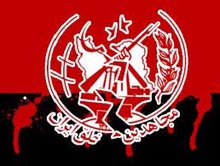
Following the 1979 Iranian Revolution in which the early Mujahedin Khalq had an almost active part, the MKO broke with the newly established Islamic government. The leader of the Islamic government of Iran viewed them as hypocrites who mixed Shiites Islam with Marxism, "a bizarre mixture". The survivor of the MKO leaders Massoud Rajavi who could not find any part in the post revolutionary Iranian politics declared armed struggle against Islamic Republic on June 20,1981. The alleged 500,000 MKO supporters launched mass demonstrations in Iranian cities announcing their ruthless armed warfare against the government using cold and warm weapons such as guns, knives, cutters and screwdrivers. The date which signified a turning point in the history of the group is annually celebrated by the MKO propaganda. Every year, the group holds events spending large amounts of money to glorify the start of its violent opposition against its nation.
About a week later, on June28 a massive explosion occurred at the headquarters of the Islamic Republic Party, killing over seventy two high ranking officials of the Iranian government including Chief Justice Ayatollah Mohammad Beheshti, four cabinet ministers (Health, Transport, Telecommunications and Energy Ministers), twenty–seven parliament members and several other government officials (according to Wikipedia).The June 28th bombing was called “Haft-e-Tir” (Tir 7th,1360/ Iranian calendar) incident by the Iranian people. Haft-e-Tir was the beginning point of the serial assassination of the Iranian officials. Two months after Haft-e-Tir, on August 30 another bomb was detonated at the office of the Prime Minister Mohammad Javad Bahonar killing him and the president Mohammad Ali Rajaie. By the way Massoud Rajavi’s violent strategy did not succeed to overthrow the Islamic Republic although a large number of the authorities were victimized by his violent terror campaign that was supposed to take over the Iranian government in 3 months.
Ali Ferasati is a former member of the MKO and the writer of the book "Peaceful Struggle, Both Strategy and Tactic” in which he condemns MKO’s violent strategy. He believes that leftist Iranians especially Mujahedin Khalq never sought peaceful solutions for the critical situation of the post revolutionary Iranian society. “Ultimately, struggle for power and the will of violent movements ended with the massacre of June 20th 1981,” Ferasati writes. “Every year in the anniversary of June 20th, the MKO launches large scale propaganda saying ‘June 20th is unquestionable’,’June 28th is unquestionable ‘.Using the term unquestionable originates in their totalitarian thinking; in today’s modern world everything is changing and relative, nothing is excluded from doubt.” (Ferasati, Ali, Peaceful struggle, Both Strategy and Tactic, P.70 and 71, in Persian)
Regarding the Haft-e-Tir bombing, Ali Ferasati writes:”The bomb used to explode Islamic Republic Party office was made of “Compressed Gas’ that had been previously invented by the United States but the Soviet Union had also achieve the technology shortly after the US. Immediately after the explosion the Soviet Union accused the US of committing the terror act because it wanted to convince the world that only the US had had the technology. It should be noted that in 1981 in a private meeting in Paris, Massoud Rajavi said that he didn’t own the technology for that explosion. Building such a complicated bomb was absolutely out of the abilities of a militant group.” Ferasati concludes that the bomb was granted to the MKO by the Soviets asking the audience this crucial question :" Did the Soviet promise them to achieve the power in Iran in three months?" (ibid, P.71)
Ferasati’s argument is not far from reality. The relations between the MKO and Russian KGB during the Cold War continued even after the revolution and during the MKO’s presence in Iraqi territory granted to them by Saddam Hussein. The following is the document released of the archives of the Soviet State microfilm collection:
Reel 1.993, File 24
Resolution of the TsK KPSS Secretariat approving a response to a letter from M. Rajavi, leader of the Mujahedin [Holy Warriors] Organization of the Iranian People, to M. Gorbachev, and to a request submitted by the organization; two copies of instructions to the Soviet Embassy in Bulgaria to be delivered in ciphered form by the Committee for State Security (KGB); extract from the minutes of the TsK KPSS Secretariat; memorandum to the TsK KPSS from R. Ulianovskii, Deputy Chief of the International Department; letter to Gorbachev from Rajavi (translated into Russian) and the original letter in Persian; statement with information about the collection of documents attached to the letter from Rajavi; memorandum (translated into Russian) to the TsK KPSS from F. Olfat, member of the Politburo of the Mujahedin Organization, and the original letter in Persian requesting that the TsK KPSS lend any amount of money (up to US$300,000,000) to the Mujahedin Organization; memorandum to the TsK KPSS from Olfat, (translated into Russian) and the original letter in Persian requesting that the supporters of the Mujahedin Organization be allowed to cross the Soviet-Iranian border and be granted a temporary asylum in the Soviet Union 1985 December – 1986 February (oac.cdlib.org)
In the critical condition of the Iranian society after the 1979 revolution, the militant groups like the MKO got ready for violence very soon. They had no idea of developing the society both politically and socially instead of resorting to terror. The MKO leader Massoud Rajavi was a power thirsty who wanted “Everything”.
By Mazda Parsi

